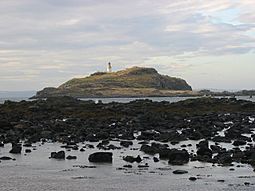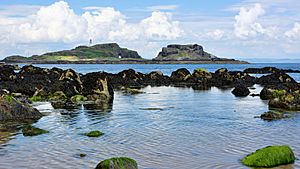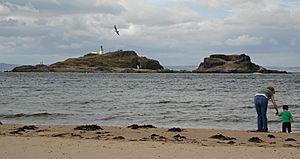Fidra facts for kids
| Gaelic name | Fiodra |
|---|---|
| Norse name | Fiðrey |
| Meaning of name | Norse for "feather island" |
 Fidra |
|
| OS grid reference | NT5186 |
| Coordinates | 56°04′N 2°47′W / 56.07°N 2.78°W |
| Physical geography | |
| Island group | Islands of the Forth |
| Area | c. 10 ha (25 acres) |
| Highest elevation | c. 20 m (66 ft) |
| Administration | |
| Sovereign state | United Kingdom |
| Country | Scotland |
| Council area | East Lothian |
| Demographics | |
| Population | 0 |
Fidra is an island off the east coast of Scotland. It's about 4 kilometers (2.5 miles) northwest of North Berwick. No one lives on Fidra, but it's a special nature reserve managed by RSPB Scotland.
Contents
What is Fidra?
Fidra is one of several islands in the Firth of Forth. These islands were formed by volcanoes about 335 million years ago. Fidra has three main parts. One end is a hill with a lighthouse on top. The middle part is low and narrow, like a bridge of land. The other end is a tall, rocky stack.
History of Fidra
The name Fidra probably comes from an old Norse word. It means "feather island," which makes sense because so many birds live there. Just like the nearby Bass Rock, Fidra is home to many seabirds. Today, it's a protected area looked after by the RSPB.
The village of Gullane is to the southwest of Fidra. The Yellowcraig nature reserve and the village of Dirleton are to the south. You can even see live pictures from cameras on Fidra at the Scottish Seabird Centre in North Berwick!
Fidra's Ancient Buildings
There are old ruins on the island. These are the remains of a chapel or a place for sick people, built in 1165. It was dedicated to a saint named Nicholas. In the 1100s, Fidra was part of a large estate called Dirleton. King David I gave this land to a family called de Vaux.
The de Vaux family built a strong fort on Fidra called Castle Tarbet. But in 1220, William de Vaux gave Fidra to the monks of Dryburgh Abbey. His family then built Dirleton Castle on the mainland instead.
Wildlife on Fidra
Fidra is a very important place for birds. The number of puffins breeding on the island has grown a lot recently. This is because a plant called tree mallow was removed. Lighthouse keepers might have planted this shrub a long time ago.
The tree mallow was blocking the entrances to the puffins' nesting burrows. In 1996, only about 400 burrows were being used. After RSPB Scotland staff and volunteers cleared the plant, over 1,000 burrows were occupied by puffins in 2016! This shows how important it is to protect their homes.
Fidra Lighthouse
| Tower shape | cylindrical tower with balcony and lantern |
|---|
The lighthouse on Fidra was built in 1885. It helps ships find their way safely. The lighthouse became automatic in 1970, meaning no one needs to live there to operate it anymore. The light flashes four times every 30 seconds. You can reach the lighthouse by a small jetty on the east side of the island.
Images for kids




